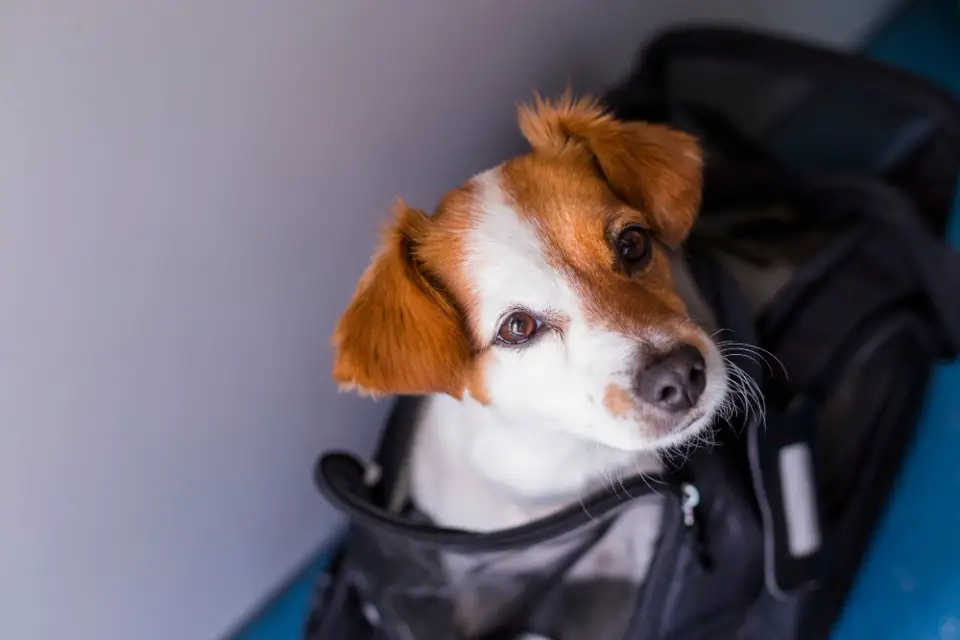Air travel is on the up again, and more and more people are now taking the chance to fly to their most-beloved destinations. And, as some of us like to do, we like to take our most-beloved furry friends with us wherever we go.
But, what exactly is involved in taking your dog on an airplane?
I was surprised how many questions arise when you think about taking your dog on an airplane.
There’s a lot more to it than you might expect. We should start with the fact that not all airlines allow dogs to fly in the cabin with their owners, and some only accept certain breeds of animals.
The process of flying with your dog isn’t complicated, but there are a lot of rules out there. With a little research and some time spent with paperwork in advance, however, you, your dog, your fellow passengers, and your airline can all have a safe — and healthy — trip from beginning to end.
Let’s have a look at everything you need to take into consideration when taking your dog on an airplane.
Where to find airline pet policies
The first thing you have to do is to find an airline that will allow your dog on the airplane.
Keep in mind that the regulations do vary from airline to airline, so it’s important to check with the individual carrier before making travel plans for your dog.
In addition to which airline you choose, whether or not your dog will be allowed on your flight is largely dependent on whether he qualifies as a service animal, and if there is room available for him in the cabin, or if he’ll need to travel in the cargo hold.
Even basic facts, such as how much you should pay to fly with your pet, are different among airlines.
Below is a list of airline pet policies from various airlines. Be sure to read these carefully before choosing an airline for your flight with your dog.
Cabin or Cargo?
The main issue to decide when it comes to taking your dog with you on an airplane is whether you will be flying with him in the cabin where you have more room and comfort, or whether he will be in cargo.
The latter option is a lot cheaper, but also a lot more restricting for your dog.
Cabin
If you are allowed to take your dog in the cabin, that’s obviously going to be a lot better for your dog than being in cargo. There are however a number of things you will need to consider beforehand.
Cabin entitlements differ from one airline to the next, and some will only allow certain types of dogs into the cabin, or even require them to be trained as service animals. If you are allowed to take your dog in the cabin, then you will also have to consider how much room you have onboard, as well as a few other factors.
The space that is allowed for animals of different sizes may vary from airline to airline. For example, if there are two of you traveling with a pet measuring up to 8 or 9 inches (20cm) high and 15 inches (38cm) tall from nose to tail, then this should be fine on most airlines.
Cargo
If you can’t take your dog in the cabin with you, or choose not to, then he will have to travel in the cargo hold instead.
Most airlines will provide you with a special dog crate that meets their safety standards, but these are often very large and very heavy. You may need help to get it to the airport as well. Make sure that the dog crate you are given is big enough for your dog to move around comfortably inside.
Choosing a flight
Before booking a flight for your dog, you’ll want to check the airline’s pet policy, but you should also consider more than just how much it costs to take your animal along.
1.) Choose the preferred time
The best time of day to take your dog on a flight is early in the morning or late in the evening when there aren’t many people around. During the summer months, this will prevent your furry friend from getting too hot.
2.) Check for layovers
You don’t want to choose a flight that has any layovers to change planes. A dog in the cargo compartment can be exposed to very high temperatures or drastic cold while the luggage is being loaded and unloaded. It may also be given improper ventilation.
3.) Avoid flying on holidays
Holiday travel is madness with all the people, luggage, and animals around, so you should avoid it if you can. Summer travel is busier than non-summer travel, but winter travel has delays as well. You could try an airline that offers direct flights if you don’t mind paying more, but this won’t always work out for your schedule.
4.) Avoid flights in the winter
Flights during the winter are cold, and your dog may not be allowed on planes before 8am or after 4pm. This is partly due to regulations concerning onboard temperature in the cargo hold during that period of time, but also because a lot of people travel with pets in spring or summer time.
Preparing your dog for the flight

Dogs are great! But dogs and flying are an acquired taste. During the course of their lifetime, some dogs will be taken on flights, while others won’t.
But if your dog is going to be flown for the first time, you’ve got to pick up some tips from other dog owners in order to make sure it goes smoothly for both you and your dog.
1.) Feed your dog 2 – 3 hours before the flight
Don’t feed your dog right before departure. Instead, try two hours before the flight, or even a bit more. This will ensure that he’s not uncomfortable during the flight due to his full stomach.
2.) Make sure that your dog has been vaccinated
Make sure that your dog has been vaccinated in advance for diseases commonly caught by dogs in air travel. Your vet will give you all the necessary papers for the travel authorities; make sure that your pet is up-to-date and vaccinated against various viruses, as well as worms and fleas.
3.) Protect your dog from the cold
If you’re planning to travel with your dog during winter, make sure that you get a jacket for him. Your dog’s coat will keep it warm enough during winter flights, even if there won’t be any heating in the cabin.
However, if your dog is used to living in a climate that is much hotter than where you live, you might have to take extra measures to keep him warm and comfy.
4.) Bring his favorite toys with
Make sure that you take your dog’s favorite toys with you on the trip. You can use these toys to keep your dog occupied during the flight.
5.) Bring dog food and water with
Take the amount of food appropriate for your dog’s flight, depending on how long you expect the trip to last. Also, bring water with you in case your dog needs some much need hydration.
Requirements and restrictions

If you are planning to travel with your pet on a regular basis, it’s a good idea to make sure that your airline has regulations regarding pets on board.
For instance, some carriers won’t allow pets in the cargo area of their aircraft. Still, others will not allow any animal in the cabin at all.
Some of these requirements will differ from airline to airline, but this will give you a good idea of what will be required.
1.) Age of your dog
Many airlines will require your dog to be at least eight weeks old, though some require dogs to be 12 weeks or older.
2.) Weight and Size of your dog
If your dog is smaller than 20 pounds, you may have found that it can fit under the seat in front of you on the airplane if he is allowed in the cabin.
While space typically varies on each flight, your dog should be able to travel under the seat as long as he or she can fit comfortably and have enough space in its pet carrier.
3.) Pet Carrier
Your dog must be in a pet carrier and it should be strong enough to be able to handle being in the cargo hold of the airplane. If your dog is traveling with you in the cabin, he will also need to be in a pet carrier.
4.) Leash
In most cases, your dog needs to be on at least a leash when he is brought to the airport. Some airlines will provide a leash and collar for you to use while flying with your dog as well.
5.) Health certificate
Most airlines require that you provide them with a certificate of good health before bringing your pet along in the cabin.
To get this, you’ll want to see your vet about 10 days in advance of your flight. The certificate must state all the appropriate vaccinations that have been given, including the rabies shot and European health certificate if traveling outside the United States.
Can I buy a seat for my dog on an airplane?
No, you can’t buy a seat for your dog on an airplane. Depending on the airline, dogs are only allowed to travel in a pet carrier as carry-on luggage in the cabin, or as checked luggage in the cargo hold.
How much does it cost to fly a dog on a plane?
The price to fly a dog on an airplane varies among airlines. If you’re flying with a small dog — for instance, a Cavalier King Charles spaniel or Yorkshire terrier – then expect to pay $100 to $125 each way. On the other hand, if your pet is large – for instance, a Great Dane or Saint Bernard – then expect to pay $200 to $250 each way.
Is it bad for dogs to fly on airplanes?
Let’s be honest, it’s not always a good idea to take your dog on an airplane. But sometimes, we have no choice but to take our furry friends with us.
The decision to fly with your dog may seem like a simple one but it is in fact a very big one. There are many things you’ll have to consider before you can safely transport your dog on an airplane.
Most dogs do well in the air – dogs are actually used as therapy animals during long flights in order to keep both passengers and crew morale up – but it may not be the kind of environment your dog is used to.
If you’re traveling with an older dog or one who is otherwise not very active, it’s probably best that he doesn’t fly at all and opts for another mode of transport instead.
If you decide to take your dog with you wherever you go, keep in mind that this is a stressful event for them as well.
Conclusion
Like humans, dogs also need to fly from time to time. They can be sent off alone or with their owners. Most of the modern airlines have pet-friendly policies in place, but there are some that do not allow dogs in their cabin.
So before you travel with your dog, make sure to check the airline’s regulations and find out if they allow dogs on board. Some airlines may only allow small breeds while some may not allow animals on board at all.
If you’re looking for pet-friendly carriers, keep an eye on the rules and requirements they have for checking pets in their cargo hold.


